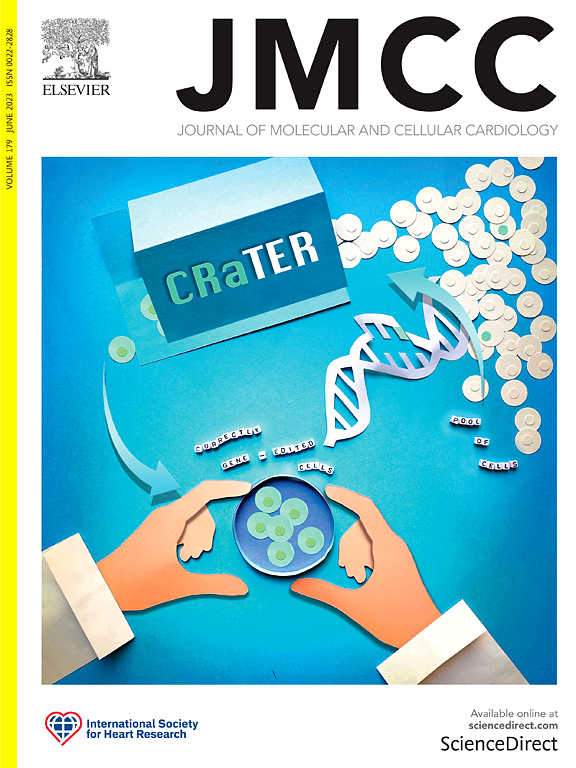抑制 miR-92a 可使射血分数保留型心力衰竭患者的血管基因表达正常化并预防舒张功能障碍。
IF 4.9
2区 医学
Q1 CARDIAC & CARDIOVASCULAR SYSTEMS
引用次数: 0
摘要
射血分数保留型心力衰竭(HFpEF)仍然是一项重大的公共卫生负担,其发病率不断上升,但有效的治疗方法却寥寥无几。内皮功能障碍和炎症被认为是 HFpEF 疾病进展的病理生理学驱动因素。人们越来越认识到,微RNA是这些病理过程的关键调控因子,而基于抗miR的疗法已在小鼠和人类中成为有前景的疗法。因此,我们测试了以抑制 miR-92a-3p 为靶点是否是一种有前景的体内 HFpEF 治疗干预方法。通过每周注射基于锁定核酸(LNA)的抗miR(LNA-92a),我们证明抑制miR-92a-3p可减轻实验性诱导小鼠HFpEF后舒张功能障碍和左心房扩张的发展。事实上,LNA-92a 会消耗 miR-92a-3p 在心肌和外周血中的表达,并以细胞类型特异性的方式抑制预测的靶基因。此外,通过对接受 LNA-92a 或 LNA-Control 治疗的 HFpEF 心脏进行单核 RNA 测序,评估了 LNA-92a 治疗的细胞特异性功效。LNA-92a 治疗小鼠的内皮细胞显示血管基因表达正常化,与内皮-间质转化相关的基因特征减少。结论:本研究表明,基于 LNA 的抗 R-92a 是针对高频心衰患者舒张功能障碍和左心房扩张的有效治疗策略。本文章由计算机程序翻译,如有差异,请以英文原文为准。

Inhibition of miR-92a normalizes vascular gene expression and prevents diastolic dysfunction in heart failure with preserved ejection fraction
Heart failure with preserved ejection fraction (HFpEF) remains a major public health burden with increasing prevalence but only few effective therapies. Endothelial dysfunction and inflammation are identified as pathophysiological drivers of HFpEF disease progression. MicroRNAs are increasingly recognized as key regulators of these pathological processes, while antimiR-based therapies have been emerged as promising therapeutics in mice and humans. Therefore, we tested whether miR-92a-3p inhibition is a promising therapeutic intervention to target HFpEF in vivo.
By injection of locked nucleic acid (LNA)-based antimiR (LNA-92a) weekly, we demonstrate that inhibition of miR-92a-3p attenuates the development of diastolic dysfunction and left atrial dilation following experimental induction of HFpEF in mice. Indeed, LNA-92a depleted miR-92a-3p expression in the myocardium and peripheral blood, and derepressed predicted target genes in a cell type-specific manner. Furthermore, cell-type specific efficacy of LNA-92a treatment was assessed by single-nuclear RNA sequencing of HFpEF hearts either treated with LNA-92a or LNA-Control. Endothelial cells of LNA-92a treated mice showed normalized vascular gene expression and reduced gene signatures associated with endothelial-mesenchymal transition.
Conclusion
This study demonstrates that LNA-based antimiR-92a is an effective therapeutic strategy to target diastolic dysfunction and left atrial dilation in HFpEF.
求助全文
通过发布文献求助,成功后即可免费获取论文全文。
去求助
来源期刊
CiteScore
10.70
自引率
0.00%
发文量
171
审稿时长
42 days
期刊介绍:
The Journal of Molecular and Cellular Cardiology publishes work advancing knowledge of the mechanisms responsible for both normal and diseased cardiovascular function. To this end papers are published in all relevant areas. These include (but are not limited to): structural biology; genetics; proteomics; morphology; stem cells; molecular biology; metabolism; biophysics; bioengineering; computational modeling and systems analysis; electrophysiology; pharmacology and physiology. Papers are encouraged with both basic and translational approaches. The journal is directed not only to basic scientists but also to clinical cardiologists who wish to follow the rapidly advancing frontiers of basic knowledge of the heart and circulation.

 求助内容:
求助内容: 应助结果提醒方式:
应助结果提醒方式:


